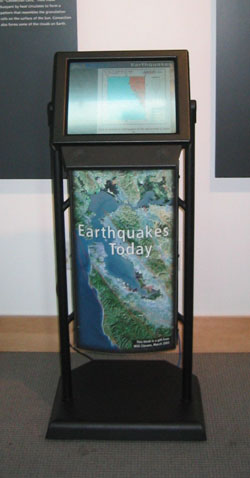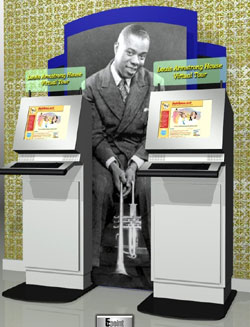Article
Kiosks give museum visitors complete picture
Visitors go to museums to be educated and entertained, and kiosks offer so much information behind the exhibit.
December 29, 2003
The three museums are quite different. But their goals are the same: using interactive kiosks to educate visitors and bring new life to exhibits.
The establishments are the National Constitution Center in Philadelphia, the Chabot Space & Science Center in Oakland, Calif., and the Louis Armstrong House and Archives in New York City. They all have in common the deployment of kiosks in this past year.
Kiosks are a natural fit in museums, and are a high-profile part of the exhibits. SeePoint Technology LLCdesigned the kiosks at the National Constitution Center and the Chabot Space & Science Center, while Fivepoint LLC designed the units at the Louis Armstrong House.
John Thuotte, vice president of sales at SeePoint, said, "By its very nature, the museum environment lends itself perfectly to information kiosks. People are going to museums to learn, and kiosks offer so much information behind the exhibit or the picture."
"Being interactive, kiosks offer a whole new medium. They are a multimedia learning tool."
|
Sydney Arfin, vice president at SeePoint, added, "Why do we have museums? To share knowledge. Now museums can use advancements in technology to pique visitors' interest."
In the case of the Louis Armstrong House, kiosks also solved a serious problem of accessibility for disabled visitors.
Michael Cogswell, director of the Louis Armstrong House and Archives, said the house in Queens is a "little Archie Bunker-type" frame house. If the designers were to make the house handicapped accessible with wider hallways and elevators, they would destroy the historic fabric of the house. So instead of bringing disabled visitors to the upper two floors, kiosks bring those floors to them.
Visitors on the main floor can use a kiosk to virtually tour a room, see it in a 360-degree angle-and even hone in on the very pictures on the wall.
Challenges of the market
What are the challenges for kiosk designers in the museum environment? Design and funding, according to the vendors.
Arfin said, "The aesthetics of the kiosk are important. Museums are design-focused. A big, bulky system is not what they want. They need enclosures that will compliment the displays. You don't put a cheap kiosk below a multimillion-dollar painting."
Added Edward Crowley,vice president of sales and business development at Fivepoint, "The challenge with any program is to provide a solution which communicates a consistency of character with the overall program identity, brand and thematic program, as well as supporting the unique environment of use.
"Museum programs are generally highly specialized content, often limited budgets and require attention to an often broader user demographic."
One thing is clear about the development of a kiosk project for this type of environment. Both the museum directors and the kiosk vendors need to be on the same page in terms of the objectives of the project and the limitations of the contract. In many cases, museums are not-for-profit organizations that are working with grants and donations.
In the case of the Louis Armstrong House, Crowley knew that the RFP had no flexibility in terms of funding. Yet the organization wanted enclosures to match the existing exhibit cases and applications that would allow users to view every room and select an object like a trumpet and literally twirl it around to see every angle.
"We talked with our application partner, M360, to decide if we could provide the organization what it asked for in the RFP. We decided that the benefits to our two companies, and more importantly, to the organization, far outweighed any financial gain," he said.
Thuotte said museums themselves have a unique perspective on ROI. "They don't track usage. It's different from a retail applications in which metrics are closely tracked. You can't measure how many people are becoming more educated on a painting. The kiosk is part of an experience."
Constitutional right
Citizen participation in government is the experience at the National Constitution Center, which opened on July 4, 2003. The building was conceived by world-class designers, so the kiosks themselves had to be special, Arfin said.
SeePoint's CounterPoint VR, featuring a space-saving and aesthetic, but durable cast metal computer enclosure, met the center's needs for the Llewellyn Citizens' Café installation. Each kiosk features a silk screen of the center's U.S. flag-inspired logo.
Visitors relaxing in the Shahara Ahmad-Llewellyn and J. Bruce Llewellyn Citizens' Café have access to eight interactive computer kiosks. From the kiosks, visitors can register to vote; contact local, state and federal officials; find out about government resources and get up-to-the-minute information about current legislation and elections.
 |
SeePoint kiosk at Chabot Space & Science Center |
Tracking tremors
At the Chabot Space & Science Center, visitors use touchscreen computer kiosks to access information about worldwide earthquake activity practically as it happens.
The kiosks in the center's Planetary Landscapes Exhibit provide real-time maps of recent earthquake activity in California, the nation and the world; real-time seismograms; regional earthquake activity reports and information about recent significant earthquakes from the United States Geological Service's Web site.
Said Steven dos Remedios, IT manager at the center, "Interactive kiosks have to attract visitors and appeal to their curiosity and sense of fun. Finding ways to achieve this for very dry topics can be a challenge." He estimated that the center spent about $20,000 on kiosks related to a separate exhibit on Mars.
Chabot officials said about 250,000 visitors, including 50,000 schoolchildren, will use the freestanding kiosk systems each year. The center uses SeePoint's freestanding designs, as well as wallmount, flush-to-wall and tabletop kiosks. The museum developed its own software and applications.
Dos Remedios said, "Kiosks are a staple for all our exhibits. We try to have something for all learning styles -- hand-on activities, reading, listening and interacting.
The configuration selected by Chabot includes wireless Internet connectivity, which is available on all SeePoint products.
Arfin said museums appreciate wireless connectivity because it lends itself to a "clean" design. Of course the exhibits can be moved more readily, as well.
SeePoint has eight museum customers, including the John G. Shedd Aquarium in Chicago, which is close to deployment, and a prominent museum in southern California.
The museum, which SeePoint cannot name by agreement, has 25 kiosk systems and plans to double that amount next year.
 |
Fivepoint kiosk at Louis Armstrong House |
Trumpeting success
The Louis Armstrong House and Archives opened October 2003, and has entertained between 4,000 and 5,000 visitors already.
Two kiosks let visitors explore the house and its contents. The kiosk also offers the bonus of information held off-site at the archives at Queens College.
The archives hold 650 home-recorded tapes, trumpets, passports, photos of Armstrong in his house and more, Cogswell said. Text accompanying all of the photos on the kiosk offer a real glimpse into Armstrong's character, eccentricities and generous nature, according to Crowley.
Cogswell laughed, "The visitors on the kiosks actually get more information than those taking the real house tour."













